KEP Technologies’ solutions to the challenges of the hydrogen sector
Date: - Categories: Brands / Engineering
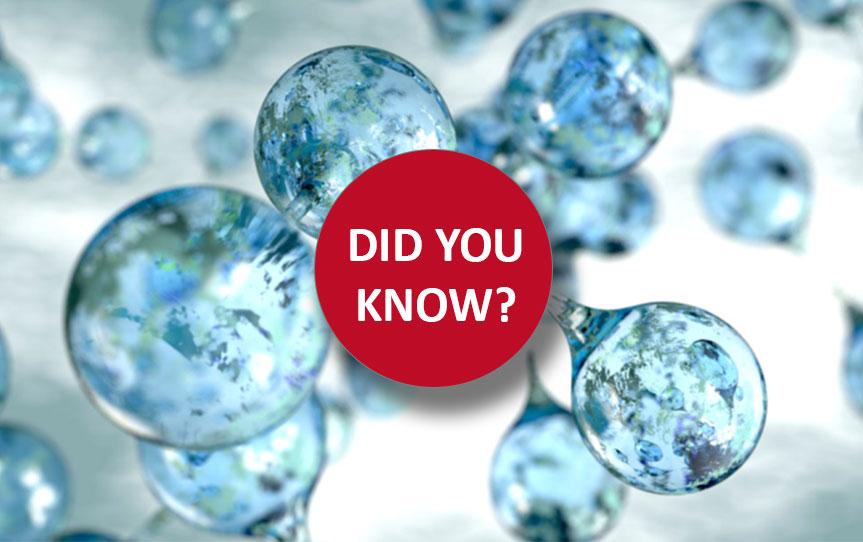
For several years, hydrogen has been a highly coveted sector, both ecologically and economically. European countries are investing more and more in this energy vector, especially for its impact on reducing greenhouse gas emissions.
Hydrogen has become a real challenge in the development of our energies, which can be broken down into 4 aspects
- Production
- Storage
- Distribution
- Conversion
Challenge – 1. Hydrogen production
Several techniques exist to produce hydrogen, one of the most widespread is the steam reforming of natural gas. This is a reaction of methane with water to form hydrogen and CO2.
The second technique to produce hydrogen is water electrolysis, which is the reaction between the electricity produced and water. In this approach, the cost and lifetime of the materials used, especially the separators, are limited.
It is therefore preferable to control the parts in an automated way in order to make their large-scale production reliable.
If new materials are considered, it is also important to characterize their stability.
Hydrogen production can also be achieved by processing biomass and waste. However, the high cost of current catalysts requires an optimization of these materials. The characterization of the efficiency of potential new catalysts can therefore ultimately lead to savings.
Once hydrogen is produced, it must be stored and transported so that it can be distributed and used.
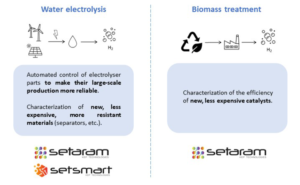
Challenge – 2. Hydrogen storage
Hydrogen can be stored in gaseous, liquid or pressurized cylinders or containers. The cost and strength of materials, components and systems can be improved by characterizing the hydrogen durability of new materials or by automated testing and inspection of systems after manufacture.
It is possible to store hydrogen in absorbent materials. However, to gain in efficiency and extend their field of application, the materials must store more hydrogen and be faster to charge and discharge the stored hydrogen. Setaram assists you in characterizing the capacity and speed of your materials.
Once the hydrogen has been properly stored and transported, it can then be distributed with the final aim of being converted for use.
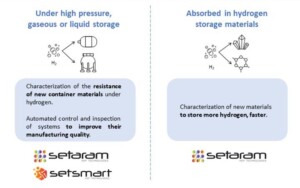
Challenge – 3. Hydrogen delivery
Hydrogen distribution is mostly about transportation and delivery.
When hydrogen is transported in gaseous form, it represents a significant maintenance cost due to the short life time of materials (steel, composites, etc.) at high pressure and/or low temperature. You may therefore have to characterize the stability of potential materials under these conditions.
When transported via a liquid carrier, this carrier has limited charge/discharge capacities and speeds. Its efficiency must therefore be characterized beforehand.
The reliability of hydrogen distribution systems (compressors, valves, nozzles, etc.) can be improved. KEP Metal Solutions designs and manufactures reliable, large-scale systems and sub-assemblies. You can also have the manufacturing of the systems and their sub-assemblies controlled by Setsmart.
The final step is the conversion of hydrogen.

Challenge – 4. Hydrogen conversion
This last step in the life cycle of hydrogen can be achieved in several ways:
By combustion in a turbine
Turbines operating with hydrogen are subjected to higher temperatures and higher vapor levels, which is why Setaram assists you in the characterization of new, more resistant alloys.
By conversion in a fuel cell
In this sector, production must change in scale and become more reliable, thanks to accurate and automatic industrial control of parts.
Moreover, if a characterization of the thermal stability of materials (such as electrolytes and membranes) is carried out, the materials will be less expensive and will hold at higher temperatures.
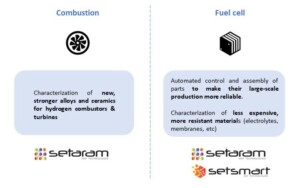
KEP Technologies, your privileged partner – Management of your hydrogen projects
KEP Technologies also assists you in the management of your complete projects. These projects can be, for example, the deployment of hydrogen production facilities as a raw material for industry, or to inject it into the gas network.They can also involve the supply of electricity for the grid or locally (off-grid).
We use our engineering capabilities and our extensive know-how in managing complex projects at all stages. You benefit from our expertise in a variety of technologies, the integration of technologies from our extensive network of partners and subcontractors, and our full range of skills. As a medium-sized company, KEP Technologies has all the industrial and financial capacities to carry out large-scale projects.
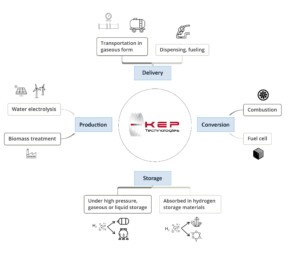
KEP Technologies supports you at every stage of the hydrogen life cycle
Find our brands :
A question, a project in the hydrogen sector?
Our teams are at your disposal. Contact us!